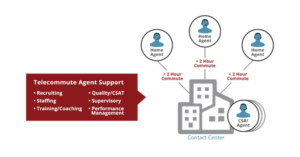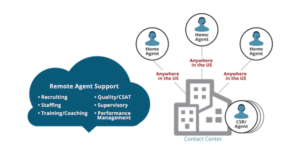The Evolution of Contact Centers
19
MARCH 2016
Eventus
Last year, the contact center consulting experts at Eventus Solutions Group published a series of three whitepapers on Home Agents. The first provided an overview of Home Agents while the second and third drilled into the operations and technology aspects of deploying home agents. One of the topics the first paper covers is the evolution of contact centers.
In just the last few decades we’ve watched contact centers transition from localized brick and mortar to near-shore and offshore operations. Now they are moving right into the home office. Until recently, the primary objective underlying every significant change in contact center operations was cost reduction, whether through technological advances or global economies. Cost has played a role in the shift to home-based agents as well, but most companies realize the biggest payback in the form of customer satisfaction.
Brick & Mortar Contact Centers
In the beginning, business units created small, localized support teams to handle customer inquiries for their products or services. As improved distribution logistics extended those products and services to distant customer populations, large companies soon found they had small pockets of customer support operations across their organization. The number of contacts grew and became expensive to support. In response, companies consolidated their fragmented customer service groups so staff could be trained on multiple products and to better address call arrival patterns and seasonality.
The consolidated contact center realized massive gains in operational efficiency. Businesses lowered interaction handling times and improved customer satisfaction further by implementing call routing, call recording and call status measurements. They used sophisticated scheduling algorithms to achieve staffing efficiencies and sought to achieve a precise balance between the average handle times and the average wait times customers would accept. In other words, the contact center became a laboratory of efficiency to minimize cost, maximize volumes and thus increase revenue and profitability. However, in the rush to savings, customer satisfaction was routinely left out of the formula. It became standard to treat the contact center worker as a commodity. It was cheaper to hire and train low-cost workers than it was to improve working conditions and retain skilled agents.
For this reason, particularly in the U.S., brick and mortar contact centers had short life spans. A contact center could deplete an entire population by hiring and separating volumes of employees from the region. That location would then close and another open in a new area to start the cycle all over again.
Offshore Contact Centers
Thanks to advancements in communications technology in the 1990s, companies found a new way to reduce contact center costs. They simply moved their contact centers to countries where wages cost less. By shifting calls across the border to a very strong labor pool in Canada, for example, operators realized a quick 25%-50% wage/cost improvement. Contact center construction in Canada exploded.
Advances in voice technology permitted calls to be shifted across borders quickly, and technology teams hotly pursued communication innovations, giving rise to an alphabet soup of acronyms like ATM, TDM, POTS, and VoIP. Thousands of jobs shifted from the U.S. to Canada, but since the U.S. economy was thriving, the exodus of jobs made little news. Near-shore operations next looked to the southern border country of Mexico, where they could achieve even greater wage savings due to the low Peso valuation. Outsourcers began training people there to speak English and even created programs such as Accent Neutralization Training to improve call quality.
Next came fiber optics and soon distance was not an issue. Big businesses could move contact centers into India where a huge population of English speakers was happy to work for wages as low as two dollars per hour. Other countries followed behind India, and the chase for international outsourcing savings for customer care became status quo.
However, the customers were not happy. Customer service accent challenges became fodder for comedians and TV show humor. Businesses also faced new and daunting audit requirements for identity protection and data security such as the Sarbanes-Oxley Audit standards, Payment Card Industry Data Security Standards (PCI-DSS compliance) and the Health Insurance Portability and Accountability Act (HIPAA). Customer satisfaction pressures and these new red tape hassles led many businesses to reconsider domestic contact centers. The question was, how could they improve domestic contact center operations and keep a lid on costs at the same time? Fortunately, technology advancements once again enabled a new paradigm in domestic contact centers, the home-based agent.
Home Agent Contact Centers
Today, end-to-end data encryption, secure desktops, cloud computing, transaction logging and reliable Internet connections make it possible for employees to operate at home just as securely and effectively as they can in the office. Contact centers can scale operations domestically without expanding seats at centralized physical locations. Even more importantly, by removing office commutes from the equation, contact centers can tap into a whole new demographic of worker.
Traditionally, U.S. domestic contact center agents are young, high school educated, with little business experience and rarely looking to stay for the long haul. The home agent workforce is markedly different. At an average age of 40 years old, home agents are more mature than their brick and mortar counterparts. In fact, 85% are college educated; 2% have post-graduate level education; and these workers typically have 10 or more years of business experience.
Businesses employ one of two home agent operation models, the Telecommute Agent model or the Remote Agent model.

Telecommute Agents typically live near a brick and mortar contact center operation that recruits and trains them, then outfits them with company equipment and sends them home to work. Operations can leverage their well-established recruiting and training processes and still achieve savings of between 3%-5% by eliminating real estate costs. They improve disaster recovery and schedule flexibility as well. Companies will often maximize their return on capital by filling offices completely and then supplementing the operation with staff that operate from home.

In the Remote Agent model, contact centers source, recruit, train and manage employees remotely. The agents provide their own equipment and typically apply online. This model requires significant changes to all support processes, but the savings can reach 7%-15% over similar brick and mortar operations by eliminating desktop capital costs, real estate costs and by offering a slightly lower wage due to the attractiveness of the employment model. While the cost savings are not nearly the magnitude of savings from offshore contact centers, when you combine the cost advantages with the other business benefits of home agent contact centers, the implementation cost is often very well justified.
Home Agent Benefits
Both home agent models make it possible for contact centers to serve their customers better while saving money at the same time. Now businesses can take advantage of a broad and geographically diverse pool of U.S.-based call agents without dedicating real estate resources to them. Among other things, the home agent contact center:
- Supports strong business continuity options and increases time zone diversity thanks to geographically distributed agents
- Limits geo-political vulnerability and data security risks compared to offshore operations
- Eliminates real estate costs
- Improves occupancy across all centers through seasonal and daily schedule flexibility
- Scales easily without expanding seats at centralized physical locations
- Improves employee satisfaction, reduces turnover and lowers replacement training costs
- Draws upon a vast pool of mature, skilled and experienced applicants
- Allows specialization by experience, language, and professional certifications
To Learn More
If you would like to learn more about Home Agents, be sure to download our 3-part home agent whitepaper series. The first provided an overview of Home Agents ,the second delves into the operational aspects of setting up a home agent program, and the third drills into the technology aspects of deploying home agents.
Similar Blogs
Built In Honors Eventus in Its Esteemed 2024 Best Places To Work Awards
Denver, CO // January 9, 2024 —Built In today announced that Eventus was honored in its 2024 Best Places To Work Awards. Specifically, Eventus earned a place on Best Midsized Places to Work in Colorado in Denver. The annual awards program includes companies of all sizes, from startups to those in the enterprise, and honors both remote-first employers as well as companies in large tech markets across the U.S.
Eventus Solutions Group, a Tech Mahindra Portfolio company, Launches Navixus™
Eventus, a leading provider of digital transformation, consulting, and business re-engineering solutions, has announced today the launch of a new business unit Navixus™, within Tech Mahindra Business Process Services (BPS). Navixus™ will combine Tech Mahindra’s Business Process Services’ automation, analytics, and consulting with Eventus’ customer experience (CX) and transformation capabilities to offer a holistic digital transformation suite to customers.


